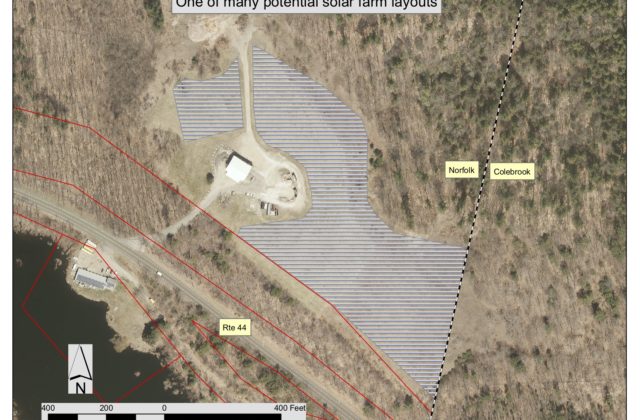Town Looks at Creating Solar Farm
Takes first steps to creating solar array at town landfill
by David Beers
On the same 149-acre town property where the transfer station is located, the town farm was established by the town in the 1800s to provide food and shelter to Norfolk’s indigent population. This was a town-run residence where destitute people were supported by town government, and those who were able-bodied did work on the farm. This property might become a farm again, but a farm of a different sort, a solar farm.
Back in 2007, former first selectman Sue Dyer and Norfolk’s Energy Task Force began pursuing the idea of installing solar panels on top of the former landfill site (the fields surrounding the transfer station). Four years ago the town put this project out to bid to different solar companies, but never quite pulled the trigger on the project due to technical and financial hurdles, and then the Energy Task Force faded away.
Now in 2019, Norfolk’s newly formed Energy Advisory Committee and its new first selectman, Matt Riiska, are again pursuing the town landfill solar farm. They are working with energy consultant, Kirt Mayland, of Reservoir Road Holdings, LLC, to pursue the needed development partner. The farm will likely be a multi-million dollar four-megawatt project that needs to be viable both for providing energy to the grid and a steady revenue to the town.
The town has just applied to Eversource for interconnection to the grid. This is a preliminary step to prepare for the upcoming Community Shared Solar program. The Community Shared Solar program is a virtual net metering program. A bit of explanation is in order. For a regular (non-virtual) net metering program, homeowners can install solar panels on their roof and enter into a contract with Eversource where any excess power they produce beyond what they use in the home goes into the grid. Eversource credits the homeowners’ electric bill for the amount provided to the grid. This is net metering.
Virtual net metering expands the pool of energy customers that enter this same contract with Eversource. So if the town produces 4000 Kilowatts (4 megawatts) and uses only 1MW for their own electric use, the remaining 3MW is shared among the other Eversource customers (solar power subscribers) that have agreed to purchase Norfolk landfill power at a reduced rate from regular power. Subscribers currently include government institutions (schools, towns, state entities) and commercial entities, but might open up to additional subscribers soon. The Community Shared Solar program will be limited in its availability each year and the competition for the program will be intense.
There is one big hurdle for solar to work at the landfill and that is having power lines, circuits and grid substations capable of handling the large amount of power produced on a sunny day. The current power line on Route 44 would most likely need to be upgraded. This could be a costly proposition. According to Mayland, if more renewable energy projects are proposed for the same power line, this might help defray the power-line upgrade costs by sharing the cost and then make the landfill solar site more economically viable.
If all of these hurdles are overcome and the site is approved for the Community Shared Solar program, the town farm would be leased to a solar company that would actually build the installation. The town would receive monthly payments at a rate yet to be determined. The lease payment amount depends on the construction/permitting costs, power line upgrade costs and power payments from Eversource. The lease payment would range from $10,000 to $18,000 per year per megawatt. So a 4-megawatt farm could bring the town over $50,000 of lease income per year, with the lease term being as long as 30 years. The town would also receive income from collecting personal property taxes on the solar infrastructure owned by the solar developer. These taxes could double the revenue for the town.
The landfill solar farm is just in the beginning stages of development and may not happen any time soon, but I think everyone involved with this effort agrees that the project has the potential to benefit electricity users, electricity producers, and the town government’s bottom line. So maybe in a few years you will want to wear your sunglasses as you gaze over the top of the dumpsters toward the bright solar panels.
Illustration, showing Route 44 and the town landfill and transfer station in the shaded gray area, by David Beers

